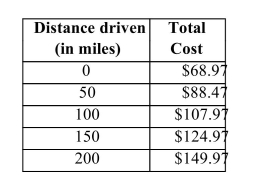The following table shows the cost of renting a full-size rental car, based on the number of miles
driven. 
a. Explain why a linear equation is appropriate for this relationship.
b. Find the slope of the line and explain what it means.
c. Find the y-intercept and explain what it means.
d. Determine the equation of the line.
e. Is this a direct variation relationship? Why or why not? Be specific.
f. I am trying to decide whether I can afford to rent a full-size car to drive to St. Louis, which is about 180
miles away. How much would that cost for a one-way trip? How much would it cost for a round trip of 360
miles?
g. Why doesn't the round trip cost twice as much as the one-way trip? Be specific.
Definitions:
Needs and Wants
Fundamental human requirements (needs) and desires or wishes that are not essential but desired (wants).
Customer Value
The perception of what a product or service is worth to a customer versus the possible alternatives.
Nonmonetary Benefits
Advantages or perks received from a job, purchase, or transaction that do not involve financial compensation, such as satisfaction, convenience, or health improvements.
Monetary Benefits
The financial gains one receives from employment or investment, including salary, dividends, or interest.
Q2: The following display from a TI-84
Q35: Convert the metric unit of length using
Q39: Write the ratio in lowest terms. 6
Q42: Plot each of the following points on
Q85: Multiply. 93.8 × 0.001<br>A)0.000938<br>B)0.00938<br>C)0.938<br>D)0.0938
Q106: Factor completely. <img src="https://d2lvgg3v3hfg70.cloudfront.net/TB5887/.jpg" alt="Factor completely.
Q109: Combine like terms. <img src="https://d2lvgg3v3hfg70.cloudfront.net/TB5887/.jpg" alt="Combine like
Q122: Use the conversions sheet to help you
Q179: Multiply. <img src="https://d2lvgg3v3hfg70.cloudfront.net/TB5887/.jpg" alt="Multiply. " class="answers-bank-image
Q252: A sofa has a wholesale price of